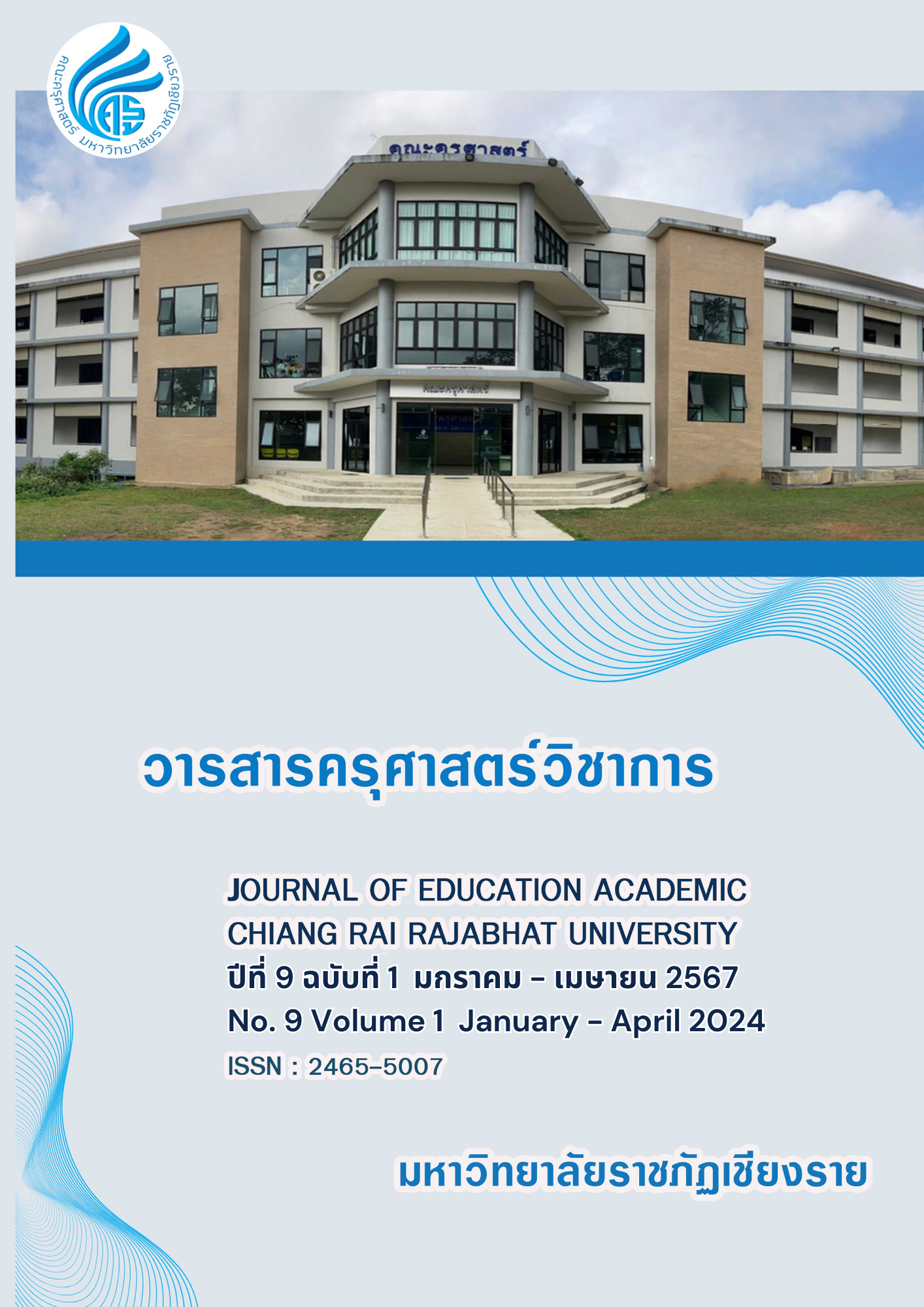Developing Competency in Explaining Phenomena Scientifically using Inquiry-Based Teaching (5Es) of students in Grade 2 at Nang Lae Kindergarten School (Ban Thung)
Keywords:
Competency in Applying Scientific Knowledge, Inquiry-Based Teaching, EfficiencyAbstract
The objectives of this research were to 1) study students' competency levels in using scientific knowledge to create reasonable explanations before using the inquiry-based learning plan (5Es). 2) To find out the effectiveness of the learning management plan. Investigative style (5Es) in developing students' ability to use scientific knowledge to create reasonable explanations. 3) To evaluate students' ability to use scientific knowledge to create reasonable explanations after using the inquiry-based learning plan (5Es). The sample group was 2nd grade students at Nang Lae Kindergarten School (Ban Thung) academic year 2023, number of 25 people, which were obtained by random sampling. The tools used in the research include: 1) Inquiry-based learning plan (5Es) to develop competency in using scientific knowledge to create reasonable explanations. 2) Competency measurement test. Statistics used include mean, standard deviation, and t-test. The results of the research found that:
1) The level of competency in applying scientific knowledge to create reasonable explanations, students had a medium level of competency at 56 percent and a high level of 24 percent, with a low level of 20 percent.
2) Students who received inquiry-based learning activities (5Es) had average scores. From the assessment of learning behavior by observing teachers. and subtests During study, it was equal to 46.52 out of a full score of 60 points, calculated as 77.53 percent, indicating that process efficiency (E1) was equal to 77.53, result efficiency (E2) was equal to 76.0 Therefore, the efficiency of the inquiry-based learning activity plan (5Es) (E1/E2) was equal to 77.53/76.00. Overall, the effectiveness index of the inquiry-based learning activity plan (5Es) has increased student knowledge. It shows that students have made progress in their studies at 77.53 percent.
3) Level of competency in applying scientific knowledge to create reasonable explanations. Students after using the inquiry-based learning plan (5Es) had a high level of competency, accounting for 52 percent, and the highest level. equal to medium level accounting for 24 percent, respectively The average performance in applying knowledge in applying scientific knowledge to create reasonable explanations of Grade 2 students at Anuban Nang Lae School (Ban Thung) after using the inquiry-based teaching technique (5E) was higher. Before use Before using the inquiry-based teaching technique (5E), the average was equal to 16.92, accounting for 56.4 percent, and after using the inquiry-based teaching technique (5E), the average was equal to 20.76, accounting for 69.2 percent.
References
กรุงเทพธุรกิจ. (2562). เกิดอะไรขึ้นกับการศึกษาไทยเมื่อผลสอบ ‘PISA’ เด็กไทยไม่ถึงค่าเฉลี่ย. สืบค้นเมื่อ 20 มีนาคม 2566. เข้าถึงได้จาก https://www.bangkokbiznews.com/news/detail/857279.
จริญญา เดือนแจ้งรัมย์, กรวลัย พันธุ์แพ และมิ่งขวัญ ภาคสัญไชย. (2564). การจัดการเรียนรู้แบบสืบเสาะผ่านบนเว็บเควสท์ เรื่อง แบบจำลองอะตอม ที่มีต่อผลสัมฤทธิ์ทางการเรียนและทักษะการคิดวิเคราะห์ของนักเรียนระดับชั้นมัธยมศึกษาปีที่ 4. วารสารพัฒนาการเรียนการสอน มหาวิทยาลัยรังสิต.
(1), 49.
ธมลวรรณ ธีระบัญชร. (2566). การจัดการเรียนรู้ด้วยเทคนิคการสอนร่วมสมัย. วารสารสังคมศาสตร์ มหาวิทยาลัยมหามกุฏราชวิทยาลัย. 6(1), 182.
ธีรยุทธ แก้วดำรงชัย และอัมพร วัจนะ. (2565). การศึกษาผลการจัดการเรียนรู้แบบ
สืบเสาะหาความรู้ (5E) ด้วยบทเรียนออนไลน์ บน Google Sites ร่วมกับเกมวัน เดอ โก เรื่องระบบนิเวศ ของนักเรียนชั้นมัธยมศึกษาปี ที่ 3. Journal of Roi Kaensarn Academi. 7(5), 10.
บังอร เสรีรัตน์. (2565). ครูกับการพัฒนาสมรรถนะผู้เรียน. วารสารศิลปากรศึกษาศาสตร์วิจัย. 14(1), 1-10.
พีรพัฒน์ สังวร, สุภาณี เส็งศรี, ธนารัตน์ หาญชเล และวราพร อันตวงศ์. (2566). การศึกษาผลการจัดการเรียนรู้แบบ สืบเสาะหาความรู้ (5Es) ร่วมกับการจัดการเรียนรู้แบบร่วมมือด้วยเทคนิค Jigsaw เรื่อง Internet of Things (IoT) และSmart City สำหรับนักเรียนชั้นมัธยมศึกษาปีที่ 6. วารสารวิจัยและนวัตกรรม สถาบันการอาชีวศึกษากรุงเทพมหานคร, 6(1), 193.
ยุวพร ดวงศรีและบุญสม ทับสาย. (2561). การเรียนรู้แบบสืบเสาะ: กระบวนการเรียนรู้เพื่อปฏิรูปชั้นเรียน. วารสารสังคมศาสตร์วิจัย. 9(2), 371.
สถาบันส่งเสริมการสอนวิทยาศาสตร์และเทคโนโลยี. (2562). ผลการประเมิน PISA 2009 การอ่านคณิตศาสตร์ และวิทยาศาสตร์. สถาบันส่งเสริมการสอนวิทยาศาสตร์และเทคโนโลยี.
สถาบันส่งเสริมการสอนวิทยาศาสตร์และเทคโนโลยี. (2563). กิจกรรม GLOBE ภายใต้สถานการณ์โควิด-19. นิตยสาร สสวท. 48(224).42.
สถาบันส่งเสริมการสอนวิทยาศาสตร์และเทคโนโลยี. (2566). กรอบการประเมินด้านวิทยาศาสตร์. สืบค้นเมื่อ 1 ธันวาคม 2566. เข้าถึงได้จาก
https://pisathailand.ipst.ac.th/about-pisa/science_competency_framewark/.
สถาพร พฤฑฒิกุล. (2564). ปัจจัยเชิงสาเหตุที่ส่งผลต่อสมรรถนะสำคัญในการแก้ปัญหาของนักเรียน ชั้น มัธยมศึกษาปีที่ 3 สังกัดสำ นักงานคณะกรรมการการศึกษาขั้นพื้นฐาน ภาคตะวันออก. วารสารศึกษาศาสตร์ มหาวิทยาลัยมหาสารคาม. 14(1), 283-284.
อรพรรณ สุชาติกุลวิทย์, (2020). มนุษย์ในทรรศนะของจอห์น ดิวอี้. สืบค้นเมื่อ 23 กุมภาพันธ์ 2566. เข้าถึงได้จาก https://wisemention.com
Bloom, B.S. (1956). A Taxonomy of Educational Objectives: Handbook I The Cognitive Domain. Longman Green Co.
Bloom, B.S. (1971). Handbook on formative and summative evaluation of student learning. McGraw–Hill.
Downloads
Published
Issue
Section
License
Copyright (c) 2024 Journal of Education Academic Chiang Rai Rajabhat University

This work is licensed under a Creative Commons Attribution-NonCommercial-NoDerivatives 4.0 International License.






